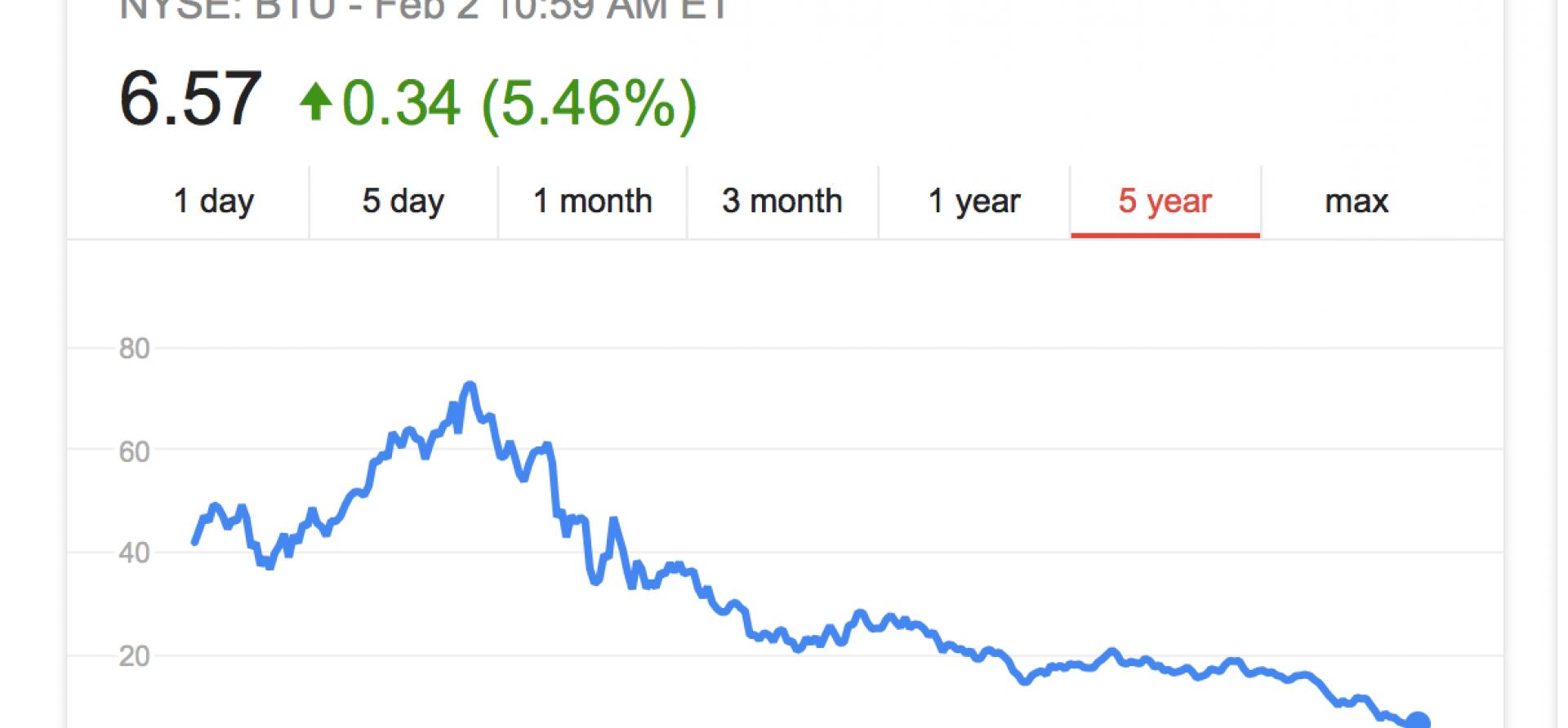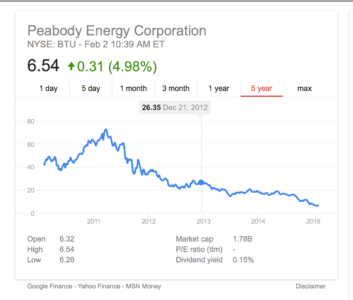Weak 2014 Numbers Worsen an Already Bad Outlook for Coal Companies

 The dim outlook for U.S. coal producers has gotten even dimmer.
The dim outlook for U.S. coal producers has gotten even dimmer.
With the release of its 2014 numbers, Peabody Energy—confirmed what we’ve been saying for some time: the U.S. coal industry has decoupled from the broader, gradually recovering economy and its spiral has deepened. We expect similarly poor performance from Alpha Natural Resources, Arch Coal and other coal producers.
Peabody, the No. 1 producer, reported net losses of $787 million, adding to the $523 million in net losses it recorded 2013. Company executives themselves see no recovery on the horizon, forecasting further losses this year. Alpha and Arch are in similar straits.
The stock prices of these companies places the truth in stark terms. Peabody shares have fallen 64 percent in just the past year, and—like Alpha and Arch—hit fresh lows last week. Peabody Energy lost 15 percent of its market-cap value last week and its stock price is down 91 percent from its five-year peak, in April 2011, of $72.71.
Alpha and Arch have become penny stocks. Alpha’s closing price on Friday was $1.02, down 98.4 percent from its five-year peak of $65.25 in January 2011. Arch coal stock traded for 92 cents at the close of business on Friday, a 97.4 percent decline from its five-year peak of $35.99 in March 2011.
As we noted in a November IEEFA report, “20 Fourth-Quarter Questions
for Powder River Basin Coal Producers” some coal-industry executives insist—despite all the evidence that suggests otherwise—on an inevitable turnaround in the years ahead.
More pragmatic leaders and champions of the industry acknowledge the severity of its financial conditions, and have conceded a reality that is more in line with analysts who see weak prices through 2015 — and then little upside potential thereafter. Some are now seeing continued weakness through 2018. In a report we did in conjunction with Carbon Tracker and published in September, “Carbon Supply Cost Curves: Evaluating Financial Risk to Coal Capital Expenditures” we describe the fundamental structural coal-industry problem. The industry is being challenged by dramatic increases in the supply of natural gas, market incursion from renewable sources and the commensurate decrease in power prices.
Past down cycles have been followed by rebounds in coal as supply and demand rebalance. This time the industry faces something historic —persistently low natural gas prices—a reality that caps the level of potential price improvement in U.S. coal markets. Coal prices can improve, but not by much, because low natural gas prices now present an ever-present source of competition. This fact limits the effectiveness of the strategy used traditionally by coal companies in a down cycle (reducing costs, cutting capex, closing mines).
Incremental coal price increases are unlikely to have a positive financial impact, in any case, given the level of debt and rising cost pressures within the coal industry. Similarly, the global economy’s slow growth and national energy policy choices are decelerating the growth rate and amount of coal use. This diminishes the likelihood that the U.S. coal industry can offset domestic loses with increased exports revenues.
We explored that harsh reality in another November report, “No Need for New U.S. Coal Ports: Data Shows Oversupply in Capacity,” in which we showed how the great hope of Powder River Basin coal producers to find salvation in foreign markets is a false hope. In the present market, and for the foreseeable future, coal exports from the Powder River Basin—which is the largest single coal reserve in the U.S.—are likely to remain unprofitable, making substantial growth improbable and causing a reconsideration of Asian exports as a viable strategy.
Back for a minute to those recently released 2014 numbers on Peabody. Its net debt rose $130 million over the year to $5.7 billion, while other non-current other liabilities (including unfunded pensions and mine rehabilitation costs) rose a collective $200 million to $2.6 billion. The company cut its stock dividend by 97 percent, a move Peabody’s board should have made some time back to better protect unfunded retired worker pensions. Its sizeable Australian operations ran at a gross cash loss for the year and it sees its Australian production falling by 5 percent this year.
Peabody continues to talk nonetheless of growth in India’s coal imports and of its hopes for a recovery in Chinese coal-import demand even after an 11 percent decline there in 2014. The company does acknowledge that total domestic coal demand could fall by more than 5 to 6 percent in 2015 but it also optimistically forecasts a rise in natural gas prices into 2017 as a potential catalyst in reversing the eight-year trend in declining U.S. domestic coal demand. Peabody at least concedes short-term difficulties, forecasting U.S. coal-export volumes to drop by another 20 to 30 percent in 2015 after declining by 17 percent in 2014.
All growth capital expenditure has been suspended, and Peabody sees its stay-in-business capex running at less than 30 percent of depreciation, an unsustainable position over the medium term that will see the company continue to shrink.
The picture for coal miners continues to get tougher by the month.
Tom Sanzillo is IEEFA’s director of finance.















